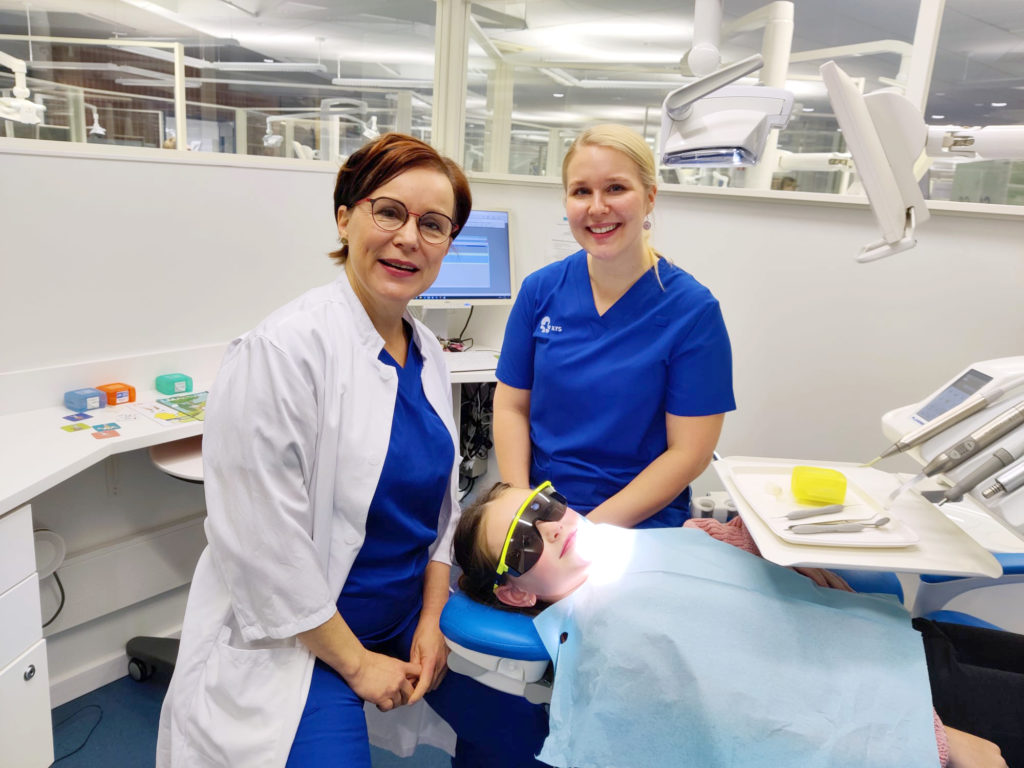
Clinical instructor Tiina Ikävalko and practical instructor Wilma Valkeapää, who provides treatment to orthodontic patients, Wellbeing Services County of North Ostrobothnia (POHDE)
Tiina Ikävalko is a professional clinical instructor who graduated as a dentist from the University of Oulu in 1988. Ikävalko initially worked as a dentist in Suonenjoki for 16 years before specializing in orthodontics in 2004 and graduating as an orthodontist in 2007. Since 2011, she has provided both theoretical and clinical training at the university and university hospital. She completed her PhD in 2016.
Ikävalko works for the University of Eastern Finland, but holds a secondary position at the Kuopio University Hospital. In addition, she provides training to specializing dentists. Ikävalko states that she is in her dream job. Not only does she get to work with students, but hospital work allows her to look at dentistry from a different perspective. Her patients include children but also patients who need orthodontic surgery in the specialized health care setting. She also treats child and adult patients at private clinics.
Dentists must master the basics of orthodontics
The basic studies in dentistry include two courses in orthodontics: identification of malocclusions and treatment of malocclusions. One lecture discusses the LM-Activator™ eruption guidance appliance.
For the first two years, the curriculum focuses exclusively on preclinical work. The undergraduate students start working at the clinic halfway through their third year, initially practicing with a phantom head at the simulation laboratory. “The students complete seven practical orthodontic exercises in the spring of their third year”, explains Ikävalko.
All dentists must possess certain basic professional skills to be able to identify existing malocclusions and unfavorable development in children. They must also learn to perform certain orthodontic first aid
procedures in case a patient’s appliance breaks down, for example. Dentists also need to be able to identify malocclusions in adults. A patient with problematic periodontology issues, for example, might have an underlying malocclusion. Dentists must also be able to provide treatment with eruption guidance appliances and Quadhelix expanders to children who need orthodontic treatment.
Working at a teaching clinic provides valuable experience to students
The hospital’s outpatient clinic serves as the teaching clinic, but the patients are children who have been referred to treatment from health centers. LM-Activators™ are used in the clinic’s treatment room, where the first orthodontic patient assigned to each dental student is a prescreened patient who needs treatment with an eruption guidance appliance. When the patient arrives for his or her appointment at the teaching clinic, the student performs the examination, takes dental impressions and photographs, and prepares the referrals for X-ray examinations. The teacher and student then review the documents together, establish the diagnosis and prepare a treatment plan. At the next visit, the LM-Activator™ eruption guidance appliance is fitted into the patient’s mouth. The student continues to monitor the patient and the effectiveness of the treatment over the next few study years.
The approach adopted by the orthodontic teaching clinic in Kuopio is ideal for learning about early orthodontic treatment in children. “The dental students are personally involved in the examination of the patients and the planning and implementation of treatment from the start. They are able to see the results of their own work when they treat the same patient with LM-Activator™ from the start until the end of the treatment”, says Tiina Ikävalko.
Specializing in orthodontics
In Finland, dentists and dental specialists are trained in four cities: Oulu, Kuopio, Turku and Helsinki. Training for dentists wanting to specialize in orthodontics is also provided in Tampere. A total of 40 new dental students start their studies in Kuopio every year.
There are always a few students in each class who develop a special interest in orthodontics. Applications for orthodontic specialization studies are accepted annually, and the professors keep an eye on the situation.
“Students apply for the right to study at the university and find a residency on their own, although this can sometimes be a challenge, because a residency also always requires a suitable supervisor”, explains Ikävalko.
The practical work included in the specialization is carried out partly at the hospital and partly at a health center.
Orthodontic treatment with the LM-Activator™ eruption guidance appliance is easy and cost-effective especially when carried out in co-operation with general dental practitioners and dental hygienists. Once the diagnosis has been established and the treatment plan has been prepared, the orthodontic specialists can focus on other tasks.”
Tiina Ikävalko, Dental and Orthodontic Specialist, D.D.Sc
LM-Activator™ article no 4

